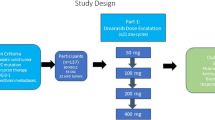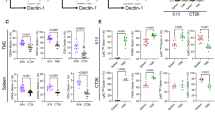Abstract
PLX4032 is a BRAF-selective inhibitor shown to be efficacious in the treatment of melanomas presenting with the BRAFV600E mutation. However, favorable responses to treatment are short-lived, and complete remission is rarely observed. Therefore, it is important to identify novel therapies designed to enhance treatment responses and to increase the longevity of initial response to BRAF inhibitors. To this end, we characterized the effects of the 225.28 chondroitin sulfate proteoglycan 4 (CSPG4)–specific monoclonal antibody (mAb) capable of blocking multiple signaling pathways important to cell growth, migration, and survival. Addition of 225.28 to the treatment regimen enhanced the in vitro response magnitude and the duration efficacy of PLX4032 in treating CSPG4+, BRAFV600E melanoma cells (melanomaBRAF(V600E)/CSPG4+ cells). Data presented in this report demonstrated that (1) treatments comprised of PLX4032 and mAb 225.28 were more effective at inhibiting melanomaBRAF(V600E)/CSPG4+ cell growth than either agent alone, (2) mAb 225.28 prevented/delayed the development of resistance in melanomaBRAF(V600E)/CSPG4+ cells to PLX4032, and (3) the mechanism of action of the combination therapy caused a down-regulation in multiple signaling pathways. This study provides a foundation for future investigations designed to improve BRAF inhibitor effectiveness in vitro and in vivo for treating melanomaBRAF(V600E)/CSPG4+ cells in combination with a CSPG4-specific mAb.





Similar content being viewed by others
References
MacKie RM, Hauschild A, Eggermont AM. Epidemiology of invasive cutaneous melanoma. Ann Oncol. 2009;20(Suppl 6):1–7.
Cooper JS. Radiation therapy of malignant melanoma. Dermatol Clin. 2002;20:713–6.
Cascinelli N, Santinami M, Maurichi A, Patuzzo R, Pennacchioli E. World Health Organization experience in the treatment of melanoma. Surg Clin North Am. 2003;83:405–16.
Flaherty KT, Puzanov I, Kim KB, et al. Inhibition of mutated, activated BRAF in metastatic melanoma. N Engl J Med. 2010;363:809–19.
Flaherty KT, McArthur G. BRAF, a target in melanoma: implications for solid tumor drug development. Cancer. 2010;116:4902–13.
Gossage L, Eisen T. Targeting multiple kinase pathways: a change in paradigm. Clin Cancer Res. 2010;16:1973–8.
Smalley KS, Flaherty KT. Integrating BRAF/MEK inhibitors into combination therapy for melanoma. Br J Cancer. 2009;100:431–5.
Montagut C, Sharma SV, Shioda T, et al. Elevated CRAF as a potential mechanism of acquired resistance to BRAF inhibition in melanoma. Cancer Res. 2008;68:4853–61.
Janne PA, Gray N, Settleman J. Factors underlying sensitivity of cancers to small-molecule kinase inhibitors. Nat Rev Drug Discov. 2009;8:709–23.
Poulikakos PI, Zhang C, Bollag G, Shokat KM, Rosen N. RAF inhibitors transactivate RAF dimers and ERK signalling in cells with wild-type BRAF. Nature. 2010;464:427–30.
Nazarian R, Shi H, Wang Q, et al. Melanomas acquire resistance to B-RAF(V600E) inhibition by RTK or N-RAS upregulation. Nature. 2010;468:973–7.
Johannessen CM, Boehm JS, Kim SY, et al. COT drives resistance to RAF inhibition through MAP kinase pathway reactivation. Nature. 2010;468:968–72.
Campoli M, Ferris R, Ferrone S, Wang X. Immunotherapy of malignant disease with tumor antigen-specific monoclonal antibodies. Clin Cancer Res. 2010;16:11–20.
Wang X, Osada T, Wang Y, et al. CSPG4 protein as a new target for the antibody-based immunotherapy of triple-negative breast cancer. J Natl Cancer Inst. 2010;102:1496–512.
Wang X, Wang Y, Yu L, et al. CSPG4 in cancer: multiple roles. Curr Mol Med. 2010;10:419–29.
Yang J, Price MA, Neudauer CL, et al. Melanoma chondroitin sulfate proteoglycan enhances FAK and ERK activation by distinct mechanisms. J Cell Biol. 2004;165:881–91.
Yang J, Price MA, Li GY, et al. Melanoma proteoglycan modifies gene expression to stimulate tumor cell motility, growth, and epithelial-to-mesenchymal transition. Cancer Res. 2009;69:7538–47.
Bao W, Stromblad S. Integrin alphav-mediated inactivation of p53 controls a MEK1-dependent melanoma cell survival pathway in three-dimensional collagen. J Cell Biol. 2004;167:745–56.
Schrama D, Keller G, Houben R, et al. BRAFV600E mutations in malignant melanoma are associated with increased expressions of BAALC. J Carcinog 2008;7:1.
Sondergaard JN, Nazarian R, Wang Q, et al. Differential sensitivity of melanoma cell lines with BRAFV600E mutation to the specific Raf inhibitor PLX4032. J Transl Med 2010;8:39.
Yang H, Higgins B, Kolinsky K, et al. RG7204 (PLX4032), a selective BRAFV600E inhibitor, displays potent antitumor activity in preclinical melanoma models. Cancer Res. 2010;70:5518–27.
O’Reilly KE, Warycha M, Davies MA, et al. Phosphorylated 4E-BP1 is associated with poor survival in melanoma. Clin Cancer Res. 2009;15:2872–8.
Domenzain-Reyna C, Hernandez D, Miquel-Serra L, et al. Structure and regulation of the versican promoter: the versican promoter is regulated by AP-1 and TCF transcription factors in invasive human melanoma cells. J Biol Chem. 2009;284:12306–17.
Bollag G, Hirth P, Tsai J, et al. Clinical efficacy of a RAF inhibitor needs broad target blockade in BRAF-mutant melanoma. Nature. 2010;467:596–9.
Campoli MR, Chang CC, Kageshita T, Wang X, McCarthy JB, Ferrone S. Human high molecular weight-melanoma-associated antigen (HMW-MAA): a melanoma cell surface chondroitin sulfate proteoglycan (MSCP) with biological and clinical significance. Crit Rev Immunol. 2004;24:267–96.
Perosa F, Ferrone S. Syngeneic antiidiotypic monoclonal antibodies to the murine anti-HLA-DR, DP monoclonal antibody CR11-462. Hum Immunol. 1988;23:255–69.
Temponi M, Kageshita T, Perosa F, Ono R, Okada H, Ferrone S. Purification of murine IgG monoclonal antibodies by precipitation with caprylic acid: comparison with other methods of purification. Hybridoma. 1989;8:85–95.
Burg MA, Nishiyama A, Stallcup WB. A central segment of the NG2 proteoglycan is critical for the ability of glioma cells to bind and migrate toward type VI collagen. Exp Cell Res. 1997;235:254–64.
Burg MA, Grako KA, Stallcup WB. Expression of the NG2 proteoglycan enhances the growth and metastatic properties of melanoma cells. J Cell Physiol. 1998;177:299–312.
Paraiso KH, Fedorenko IV, Cantini LP, et al. Recovery of phospho-ERK activity allows melanoma cells to escape from BRAF inhibitor therapy. Br J Cancer. 2010;102:1724–30.
Halaban R, Zhang W, Bacchiocchi A, et al. PLX4032, a selective BRAF(V600E) kinase inhibitor, activates the ERK pathway and enhances cell migration and proliferation of BRAF melanoma cells. Pigment Cell Melanoma Res. 2010;23:190–200.
Villanueva J, Vultur A, Lee JT, et al. Acquired resistance to BRAF inhibitors mediated by a RAF kinase switch in melanoma can be overcome by cotargeting MEK and IGF-1R/PI3 K. Cancer Cell. 2010;18:683–95.
Flaherty K. 2011 [cited; Available from: http://www.dfhcc.harvard.edu/news/news/article/4126/334/?PHPSESSID=c84186b744715f955d507b9356d0f3b2.
Mittelman A, Chen ZJ, Yang H, Wong GY, Ferrone S. Human high molecular weight melanoma-associated antigen (HMW-MAA) mimicry by mouse anti-idiotypic monoclonal antibody MK2-23: induction of humoral anti-HMW-MAA immunity and prolongation of survival in patients with stage IV melanoma. Proc Natl Acad Sci USA. 1992;89:466–70.
Acknowledgments
This study was supported by Award P50CA121973 from the National Cancer Institute (NCI) and partially supported by Award 3P30CA047904 (the UPCI Cancer Center Support Grant) from the NCI.
Author information
Authors and Affiliations
Corresponding author
Additional information
Ling Yu and Elvira Favoino contributed equally to this research.
Rights and permissions
About this article
Cite this article
Yu, L., Favoino, E., Wang, Y. et al. The CSPG4-specific monoclonal antibody enhances and prolongs the effects of the BRAF inhibitor in melanoma cells. Immunol Res 50, 294–302 (2011). https://doi.org/10.1007/s12026-011-8232-z
Published:
Issue Date:
DOI: https://doi.org/10.1007/s12026-011-8232-z




